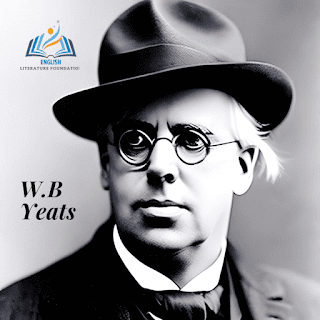Introduction
W.B Yeats was born in Dublin, Ireland in 1865, and grew up
to become one of the most celebrated poets of the 20th century. His works often
explored themes of love, death, Irish mythology, and the spiritual world. Yeats
was a key figure in the Irish literary revival, which aimed to revive and
promote traditional Irish language and culture.
Early Life and Education
Yeats was born into a Protestant family in Dublin, but he
spent much of his childhood in London. He was homeschooled until the age of 15
when he attended the Godolphin School in Hammersmith. Yeats went on to attend
the Metropolitan School of Art in Dublin, where he studied painting, and later
the Royal University of Ireland.
Yeats' Love of Irish Culture and Mythology
Throughout his life, Yeats was deeply influenced by his love
of Irish culture and mythology. He was a member of the Irish Literary Society,
which aimed to promote Irish literature and language, and he also played a key
role in the Irish National Theatre Society, which aimed to promote traditional
Irish theater.
Yeats was particularly interested in the mythology of the
Celts, and his poetry often explored the themes and characters from Irish
mythology. One of his most famous poems, "The Second Coming," makes
reference to the "rough beast" from the Book of Revelation and the
Celtic god, Lugh.
Yeats' Romantic Relationships and Marriage
Yeats had several romantic relationships throughout his
life, including with the actress and writer Maud Gonne. Yeats proposed to Gonne
several times but was ultimately rejected. However, their relationship remained
close, and Gonne continued to be a source of inspiration for Yeats' poetry
throughout his life.
In 1917, Yeats married Georgie Hyde-Lees, with whom he had
two children. Hyde-Lees was a medium, and her experiences with automatic
writing had a profound influence on Yeats' later poetry, inspiring his
exploration of the spiritual world.
The Themes of W.B Yeats' Poetry
Yeats' poetry explored a range of themes, including love,
death, Irish mythology, and the spiritual world. One of the key themes in
Yeats' poetry was the idea of cyclical history, the belief that history repeats
itself in cycles.
Another important theme in Yeats' poetry was the search for
spiritual enlightenment. Yeats believed that the spiritual world was just as
real as the physical world, and he explored this belief in his poetry.
An Analysis of Yeats' Most Famous Poems
Yeats' poetry is renowned for its beauty and depth of
meaning. Here are some of his most famous poems and a brief analysis of their
themes:
"The Lake Isle of Innisfree"
This poem explores the idea of escape to a peaceful, idyllic
place where one can find solace and reconnect with nature. The speaker of the
poem longs to leave the chaos and noise of the city and retreat to a tranquil
island, where he can live a simple life and find inner peace. The poem is a
celebration of the beauty of nature and the importance of taking time to
connect with the natural world.
"When You Are Old"
This poignant poem is a reflection on love and the passage
of time. The speaker addresses an old flame, urging her to remember the love
they shared in their youth. The poem is a reminder that love is fleeting and
that we should cherish it while we can. It is also a reflection on the
inevitability of aging and the bittersweet memories that come with it.
"The Second Coming"
This dark and powerful poem is a reflection on the chaos and
uncertainty of the modern world. The poem draws on the imagery of the Book of
Revelation and the mythology of the Celts to convey the idea of a world on the
brink of collapse. The poem is a warning of the dangers of unchecked ambition
and the need for a new moral order to replace the old.
"Easter 1916"
This poem is a reflection on the events of the Easter Rising
in Dublin, Ireland in 1916. The poem is a tribute to the men and women who
fought for Irish independence, but it also acknowledges the futility and
tragedy of war. The poem is a powerful reminder of the cost of freedom and the
sacrifices that must be made to achieve it.
The Use of Symbolism in Yeats' Poetry
Symbolism is a key feature of Yeats' poetry, with many of
his poems featuring complex imagery and metaphors. One of the most famous
examples of this is the "gyres" that feature in many of Yeats' poems.
The gyres represent the cyclical nature of history and the idea that the world
is constantly moving in cycles.
Other common symbols in Yeats' poetry include the moon,
which often represents the feminine, and the swan, which is a symbol of grace
and beauty. Yeats' use of symbolism is a reflection of his interest in the
spiritual world and his belief in the power of metaphor to convey complex
ideas.
Yeats' Influence on Modern Literature
Yeats' poetry has had a profound influence on modern
literature, inspiring countless poets and writers over the years. His use of
symbolism, his exploration of Irish mythology, and his interest in the
spiritual world have all been major influences on the work of later writers.
One of the most famous examples of Yeats' influence is the
work of the poet Seamus Heaney, who was deeply influenced by Yeats' use of
language and his exploration of Irish culture and history.
Conclusion
W.B Yeats was one of the most celebrated poets of the 20th
century, and his work continues to inspire and captivate readers today. From
his exploration of Irish mythology to his use of symbolism, Yeats' poetry is a
reflection of his deep and abiding love for the world of literature and the
power of language to convey complex ideas.
FAQs
- What
inspired Yeats' interest in Irish mythology?
Yeats was deeply interested in the mythology of the Celts,
which he believed offered a rich source of inspiration for his poetry. He was
also influenced by the Irish literary revival, which aimed to promote Irish
language and culture.
- How
did Yeats' personal life influence his poetry?
Yeats' personal life, including his relationships and his
interest in the spiritual world, had a profound influence on his poetry. His
experiences with love, loss, and the search for meaning are all reflected in
his work.
- What
is the significance of the "gyres" in Yeats' poetry?
The gyres represent the cyclical nature of history and the
idea that the world is constantly moving in cycles. This concept is a recurring
theme in Yeats' work, and it reflects his belief that history is not a linear
progression, but rather a series of cycles that repeat themselves.
- What
is the meaning behind the swan symbol in Yeats' poetry?
The swan is a symbol of grace, beauty, and transformation in
Yeats' poetry. It often represents the beauty and mystery of the natural world,
as well as the power of transformation and renewal.
- How
has Yeats' poetry influenced modern literature?
Yeats' poetry has had a profound influence on modern
literature, inspiring countless writers and poets to explore new ways of
expressing themselves. His use of symbolism, his exploration of Irish
mythology, and his unique poetic style have all been major influences on modern
literature.

